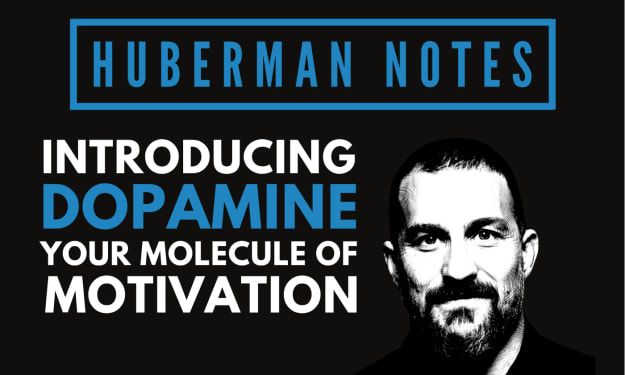Motivation = Pain + Pleasure
Here's what that means for you...

Right about 30+ lifetimes ago, a former Indian prince noticed an emotional nuance while investigating his internal landscape.
Desire — or motivation, by another name — has a dual nature.
The Buddha was right, and the logic behind his astute observation lies in the dopamine system.
We should all understand this lesson to be wiser about our behavior.
About The Huberman Notes
The Huberman Notes presents the best tools, practices, and protocols from The Huberman Lab Podcast.
Each episode of the podcast contains about two hours of dense information. It can feel like drinking from a firehose.
So these posts are designed to be shorter and useful supplements to the podcast.
Dopamine: The Molecule of Motivation
Dopamine is fundamental for how you feel and how motivated you are. Its double-edged nature makes it essential to understand, as it can make or break your life.
In this series, we’re investigating this fascinating molecule, and learning how we can harness its power to sustain long-term energy and motivation in pursuit of our goals.
Check out the first post on dopamine here.
Is Dopamine the Same as Pleasure?
A common myth is that dopamine is responsible for pleasure and enjoyment. And indeed, dopamine is released when we experience things we like.
But this is not the right way to conceptualize it.
A rat experiment illustrates the difference.
Scientists got rats to press a lever. With each push, the rats could enjoy a pellet of savory rat food.
For dessert, the scientist exterminated their dopamine neurons by injecting a neurotoxin.
What happened?
The rats continued to press the lever and eat the food. They were still able to enjoy the food.
But — if moved a mere body length (that of a rat, mind you) away from the lever, the dopamine-depleted rats would not move. They had no motivation to move towards pleasure.
Thus, dopamine is not about the ability to experience pleasure but about the motivation for pleasure.
Similar experiments done on humans have yet to be approved by any ethics committee.
Yet, we recognize the pattern in modern humanoids.
Even though they can experience pleasure, people with low dopamine levels are less motivated to pursue it.
We have ample opportunities to experience pleasure today, yet many people feel a bit “meh…” about pursuing them. They are low on dopamine.
We’ll explore why and the dynamics of dopamine depletion in future posts.
The Sting of Motivation
Motivation is a two-part process.
When you anticipate something, dopamine levels rise.
When you reach or engage in that thing, dopamine increases even further.
But — as you repeatedly pursue a behavior or engage in a thing you enjoy, there’s a shift away from dopamine.
Other chemicals release and trigger a low-level sense of pain.
Perhaps you won’t notice it as pain. But the craving you feel is part dopamine, and the other part is its mirror image — the pain linked with the craving for more of that thing.
This is a subtle and important feature of the dopamine system.
For every bit of dopamine released, another circuit in the brain creates a bit of pain. Think of it as a downward deflection in pleasure.
These parallel processes overlap closely in time.
Try for Yourself
It can be hard to notice but try sensing it the next time you eat something delicious. You take a bite, and it tastes terrific. But part of that enjoyment is the anticipation and wanting more of that thing.
This is true for any pleasurable experience.
So the increase in pleasure is accompanied by a sting of pain — a craving for more.
Part Pleasure, Part Pain: Pain Always Prevails
Diabolically, each time you encounter that thing you want, the experience of dopamine release and pleasure diminishes a little bit.
And conversely, the pain-response increases a little bit.
This pattern is visible in drug-seeking behavior. The first time someone tries cocaine, dopamine goes through the third floor. They will feel outstanding.
Next time won’t feel quite as good.
With each subsequent use, the pain/pleasure ratio shifts in a downward spiral of doom.
Desire Scales with Pain
With this unfortunate dynamic in mind, we realize that much of our pursuit of pleasure is to reduce the pain of craving.
Even if this pain is psychological, people can experience it as physical pain.
And an important part of their motivation is not just to obtain pleasure, but to reduce pain. This fact is apparent for those stuck in addictive behavior patterns.
But it’s also a subtle feature of every desire.
So remember — your desire scales in proportion to how pleasurable that thing is, but also how much pain you experience when you don’t have it.
Coming Up Next….
Next time, we’ll see how dopamine is closely related to anticipation. This fact unveils some of the subjective aspects of dopamine we can use to our benefit.
Further Resources to check out:
The Huberman Lab Podcast: How to Increase Motivation & Drive
The Huberman Lab Podcast: Controlling your dopamine for motivation, focus & satisfaction
The Molecule of More: How a Single Chemical in Your Brain Drives Love, Sex, and Creativity — and Will Determine the Fate of the Human Race by Daniel Z. Lieberman & Michael E. Long
Dopamine Nation: Finding Balance in the Age of Indulgence by Anna Lembke
If you want more practical tools and strategies to improve your life, you should also check out Templates for Thinking.
Most people never act on personal development strategies, so Templates for Thinking created a format that allows you to personalize what you learn through writing.
When you personalize these strategies, you can more easily act on them and reach your goals.
Don’t miss the next posts!
If you sign up for The Huberman Notes Newsletter, you'll never miss a post.
Thanks for reading - and please help share it if you know someone who can benefit from this information!
About the Creator
The Huberman Notes
The best tools & protocols from The Huberman Lab Podcast.






Comments
There are no comments for this story
Be the first to respond and start the conversation.